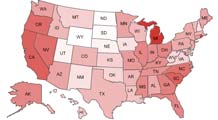Half of mortgage borrowers will be 'underwater'
An estimated 25 million borrowers will owe more than their house is worth by 2011.
| 30 yr fixed | 3.80% |
| 15 yr fixed | 3.20% |
| 5/1 ARM | 3.84% |
| 30 yr refi | 3.82% |
| 15 yr refi | 3.20% |
NEW YORK (CNNMoney.com) -- Nearly half the nation's mortgage borrowers will soon owe more on their mortgages than their homes are worth, according to a new report.
A Deutsche Bank analysis of the battered housing and mortgage markets estimated that 25 million borrowers, representing 48% of all Americans with mortgage loans, will plunge underwater before home prices are expected to stabilize in the beginning of 2011.
"If our home-price forecast is correct, roughly one in two mortgage borrowers and one in three homeowners will owe more than their home is worth," said Karen Weaver, one of the researchers who authored the report. "That's a dramatic shift from the past several decades when housing was the foundation of middle class wealth."
This estimate is even steeper than what many other experts have previously reported or predicted. First American CoreLogic estimated 11 million homeowners -- and rising -- were underwater by the end of 2008. Moody's Economy.com estimated 15 million at the end of March and projected 17.5 million by early 2010. Zillow.com reported that 20 million were already underwater at the end of the first quarter 2009.
This level of negative equity could compel more borrowers to "strategically" default -- or walk away -- particularly those who are so far underwater that they fear they'll never break even.
"Severely underwater borrowers may conclude that their property value will never recover and they may 'walk away' even if they are able to make mortgage payments," said Weaver.
Currently, 26%, of defaults are classified as strategic, according to a recently published paper by Paola Sapienza, a finance professor with Northwestern University, and Luigi Zingales, a finance professor at the University of Chicago.
They found little evidence that homeowners voluntarily default unless their equity shortfall exceeds 10%.
The Deutsche Bank paper forecasts that the percentage of borrowers who are severely underwater (25% or more) will more than double to 28%. So it's likely that the number of people voluntarily defaulting will grow quickly.
The most likely to pack it in are those borrowers who know someone else who walked away. "People who know someone who defaulted strategically are 82% more likely to declare their [own] intention to do so," claimed Sapienza and Zingales in their paper.
The twin centers of underwater world are the "sand states" and the rust belt. The worst hit metro areas are Merced and El Centro, Calif., where 85% of mortgage borrowers are underwater.
Others hard hit areas include: Modesto, Calif. (84%), Las Vegas (81%) and Stockton, Calif. (81%). The leading Florida cities are Cape Coral (76%) and Orlando (71%). Mansfield and Cleveland, Ohio, (54%) had the highest rates in the industrial Midwest.
The type of mortgage loan had a big impact on whether borrowers are underwater. For each type of loan, Deutsche Bank estimated, as of March, what proportion of mortgage holders had negative equity.
Basic conforming loans: 16%. These loans, which limit the mortgage balance to home value, were the best performing, according to Deutsche Bank.
Prime jumbos: 26%. These mortgages are of such high value that they extend beyond the cap limits for loans bought or backed by Fannie Mae or Freddie Mac.
Alt-A loans: 49%. These notes were usually issued to borrowers with good credit scores who could not or would not provide full documentation of their incomes or assets.
Subprime loans: 50%. This is what many borrowers with poor credit history were forced to rely on.
Option-ARMs: 77%. AKA negative amortization loans are the worst performing loan product of all. Under the terms of these mortgages, borrowers could make minimum payments every month -- payments that did not even cover the interest of the loans. Instead of balances shrinking over time, the amount owed grew.
This was lethal when combined with falling home prices. By 2011, Deutsche Bank predicts 89% of these borrowers will be underwater. ![]()




